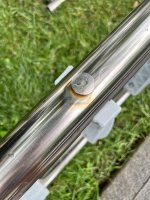I had some iron staining in my pool the last few years. We got a new liner this year, so with the fresh water I wanted to get a new ladder in case the iron was coming from the previous ladder rust.
I ordered this SR Smith marine grade ladder: https://lesliespool.com/306340.html
The new ladder is already rusting after being in the water for four days. Is this expected? Water chemistry is good:
Chlorine: 4ppm
pH: 7.7
TA: 90
CYA: 40
In ground 25k gallons using liquid chlorine.
I ordered this SR Smith marine grade ladder: https://lesliespool.com/306340.html
The new ladder is already rusting after being in the water for four days. Is this expected? Water chemistry is good:
Chlorine: 4ppm
pH: 7.7
TA: 90
CYA: 40
In ground 25k gallons using liquid chlorine.





